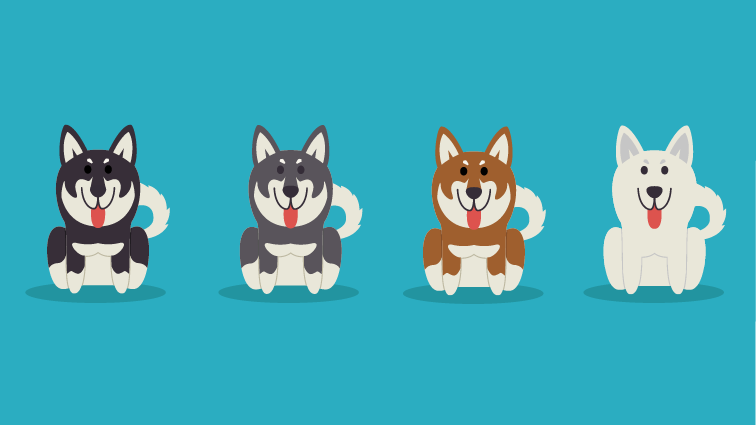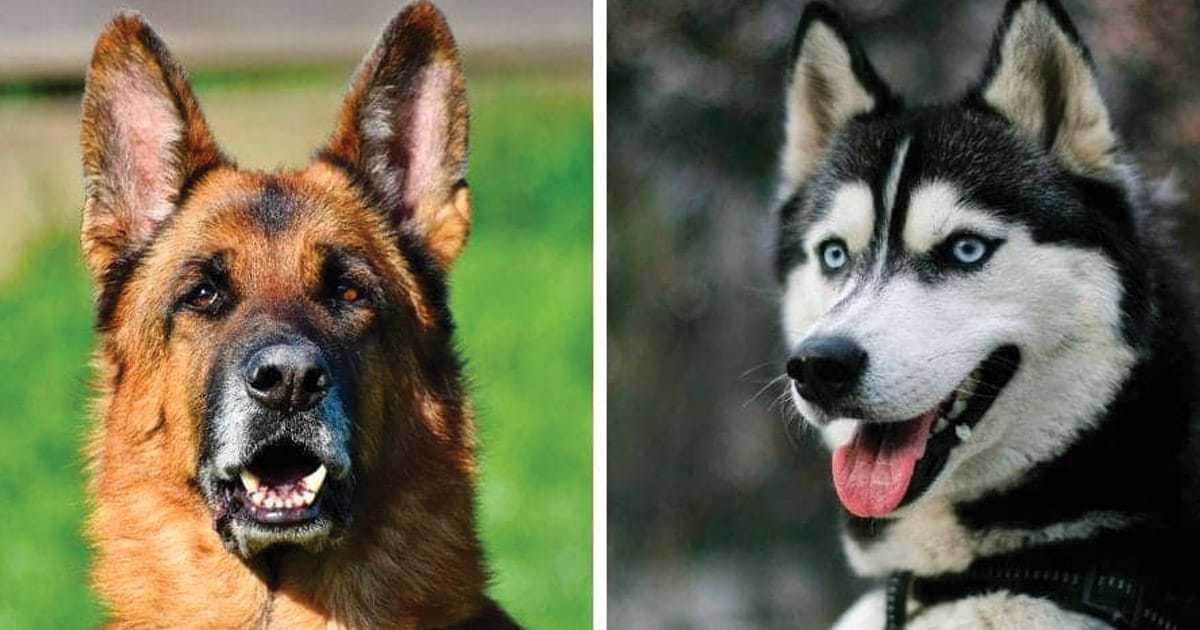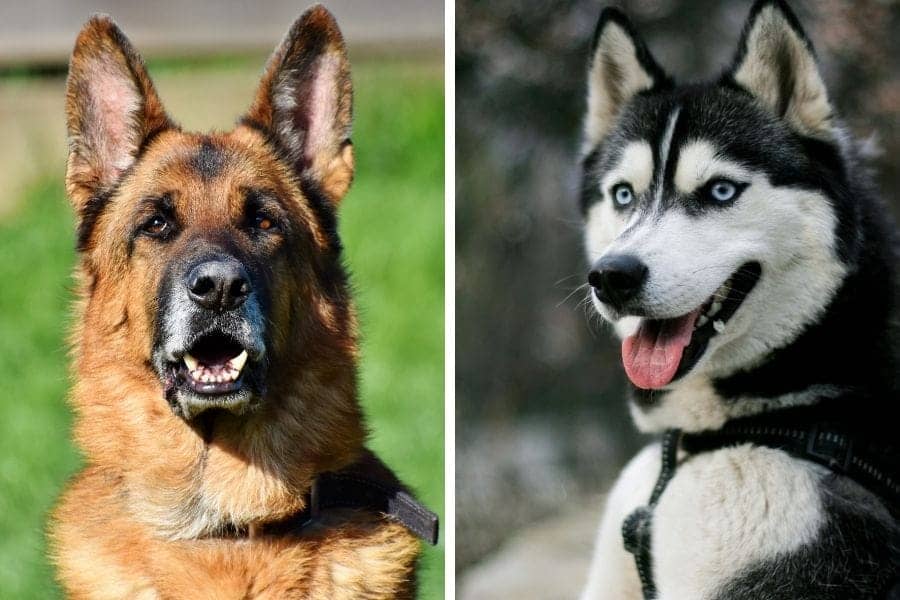German Shepherds are warier of strangers, while Siberian Huskies are more friendly. Both breeds are familiar with other dogs, but individual temperaments may vary.
When deciding between these breeds, monitoring interactions and considering their exercise needs closely is crucial. German Shepherds and Huskies both require ample time for physical activity and play.
Origins And History
Understanding the origins and history of the German Shepherd and Siberian Husky breeds provides valuable insights into their unique characteristics. Both breeds have fascinating backstories that have influenced their traits and temperaments even to this day. Let’s delve into their origins and discover what sets them apart.
Origins Of German Shepherd
The German Shepherd breed originated in Germany in the late 19th century. Captain Max von Stephanitz, a German cavalry officer, is credited with developing the German Shepherd as a versatile working dog. He aimed to create a breed that excelled in herding and guarding while possessing superb intelligence and adaptability.
Von Stephanitz achieved his goal by carefully selecting and breeding German herding dogs with specific traits such as loyalty, obedience, and athleticism. The resulting German Shepherd quickly gained recognition for its exceptional abilities and was widely used in various roles, including police and military work.
Origins Of Siberian Husky
The Siberian husky, on the other hand, originated in northeastern Siberia, Russia. The Chukchi people developed this ancient breed and relied on these dogs for transportation and sled-pulling in the harsh Arctic conditions. The Chukchis selectively bred the Siberian husky for endurance, efficiency, and a friendly and cooperative nature.
The Siberian Husky played a vital role in the survival of the Chukchi people, enabling them to traverse vast snow-covered terrains. These dogs were highly prized for their ability to excel in sledding competitions and their unwavering loyalty to their human companions.
It was not until the early 20th century that the breed gained international recognition when Siberian huskies participated in long-distance races, capturing the attention of dog enthusiasts worldwide.

Physical Appearance
Regarding physical appearance, the German Shepherd and Siberian Husky exhibit distinct characteristics that set them apart. Understanding these differences is essential to choosing the breed that suits your preferences and lifestyle. Let’s dive into the physical appearance of these two popular breeds.
Physical Appearance Of German Shepherd
The German Shepherd is known for its solid and muscular build. These dogs have a well-proportioned body, a deep chest, and a strong neck. German Shepherds have a commanding presence with an average height of 22–26 inches (56–66 cm) and a weight ranging from 50–90 pounds (23–41 kg). Their head is moderately broad and features a distinctive forward-leaning posture.
German Shepherds have a double coat that consists of a dense, harsh outer coat and a thick undercoat. This coat provides them with excellent protection against the elements. They come in various colors, including black, ebony, black and tan, and bi-color. Their bushy tail reaches down to approximately hock level.
Physical Appearance Of Siberian Husky
On the other hand, the Siberian husky displays a striking appearance with its beautiful and expressive eyes. These dogs have a compact and medium-sized frame. They stand at an average height of 20–23.5 inches (51–60 cm) with a weight ranging from 35–60 pounds (16–27 kg).
Siberian huskies have a well-muscled body, a deep chest, and a straight back. Their heads are proportionate to their bodies, with ears that are triangular and stand erect. One of their most notable features is their distinctive double coat, which consists of a dense undercoat and a longer, straight outer coat. This coat comes in various colors, including black and white, gray and white, red and white, or pure white.
Additionally, Siberian huskies have a plumed tail that is carried in a sickle shape over their back. This characteristic adds to their graceful and athletic appearance.
Temperament And Characteristics
When choosing a dog breed, understanding their temperament and characteristics is crucial. German Shepherds and Siberian Huskies are popular breeds known for their unique personalities. Let’s explore the temperament and characteristics of each breed to help you make an informed decision.
Temperament Of German Shepherd
The German Shepherd is known for its loyalty, intelligence, and protective nature. They make excellent guard dogs and are often used in law enforcement and service roles. German Shepherds are highly trainable and eager to please their owners. They are known to be courageous, confident, and alert, making them excellent family companions.
- Highly loyal and protective
- Intelligent and trainable
- Courageous and confident
- Alert and watchful
- Excellent family companions
Temperament Of Siberian Husky
The Siberian husky is a friendly, outgoing, and social breed. They are known for their playful nature and love for people, including strangers. Unlike German Shepherds, Siberian huskies may not be the best guard dogs due to their friendly and welcoming disposition. They are pack-oriented and get along well with other dogs. Siberian huskies require regular exercise and mental stimulation to prevent boredom and destructive behavior.
- Friendly and sociable
- Playful and energetic
- He gets along well with other dogs
- Pack-oriented
- Requires regular exercise
Each breed has its unique temperament, and choosing between a German Shepherd and a Siberian Husky depends on your lifestyle and preferences. German Shepherds are ideal for those seeking a loyal and protective family companion, while Siberian Huskies are great for those looking for a friendly and sociable dog. Regardless of the breed, proper training and socialization are essential for both breeds to ensure they grow well-behaved and balanced dogs.


Frequently Asked Questions Of German Shepherd Vs. Siberian Husky: Breed Differences And Similarities
Are Huskies And German Shepherds Similar?
Huskies and German Shepherds are similar in being friendly with other dogs but differ in their attitudes towards strangers. German Shepherds are warier of unknown people, while Huskies are generally more open and closed. It’s important to monitor interactions with other dogs to ensure safety.
What Would A Husky And A German Shepherd Look Like?
A husky and a German Shepherd would have a mixed appearance, combining traits from both breeds. The Shepsky coat can mix colors like brown, black, cream, white, red, and blue. They are generally friendly with people and other dogs, but monitoring their interactions is essential.
What Is The Difference Between The Different Breeds Of Huskies?
The different breeds of huskies, such as the Alaskan Husky and Siberian Husky, differ in size, temperament, and activity level. Siberian Huskies are more people-friendly and accepting of strangers, while German Shepherds are loyal to their families and wary of new people.
Both breeds require high exercise levels and proper training.
How Are Huskies Different From Other Dogs?
Siberian huskies are intelligent and independent dogs. They need firm, gentle training and love running. They are more people-friendly and accepting of strangers compared to German shepherds. German shepherds are loyal to their family and cautious of new people. Both breeds require high exercise and playtime.
Conclusion
German Shepherds and Siberian Huskies have similarities and differences that make them unique breeds. While German Shepherds are warier of strangers, Huskies are more open and friendly. Both breeds generally get along well with other dogs, but monitoring interactions is essential.
Shepskies, a mix of the two breeds, have a coat that combines the colors and patterns of their parents. These breeds have high exercise requirements and need an owner who can provide ample physical activity and playtime. Consider your lifestyle and preferences when choosing between these two unique breeds.
